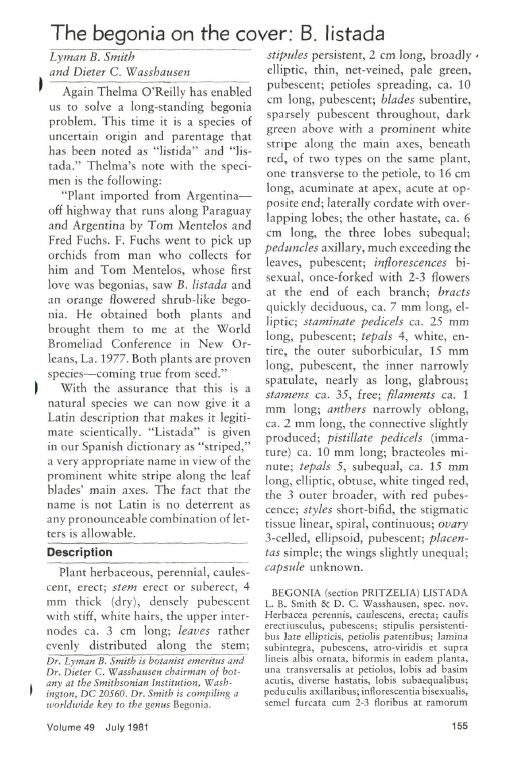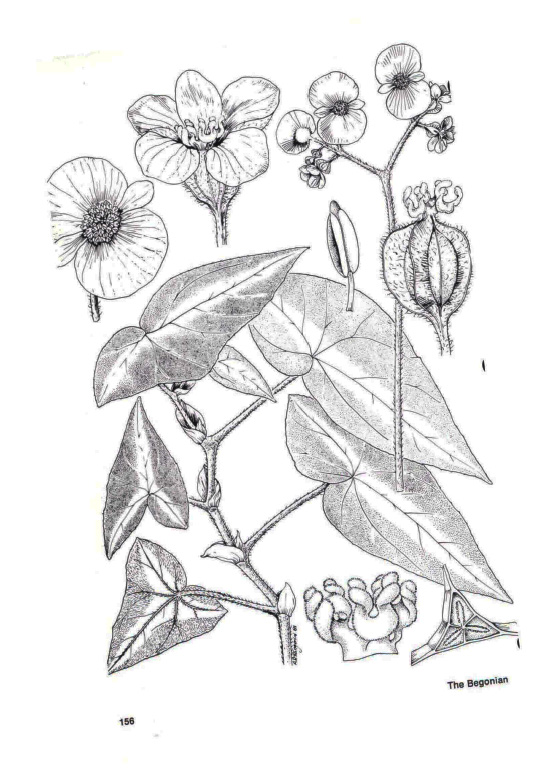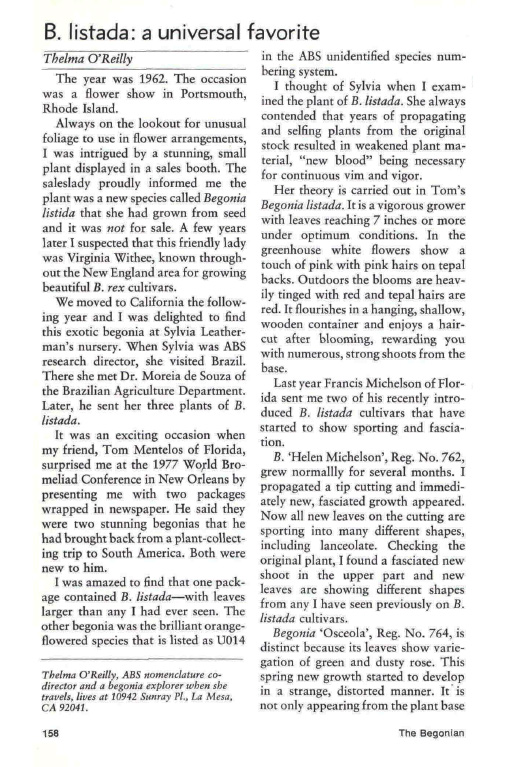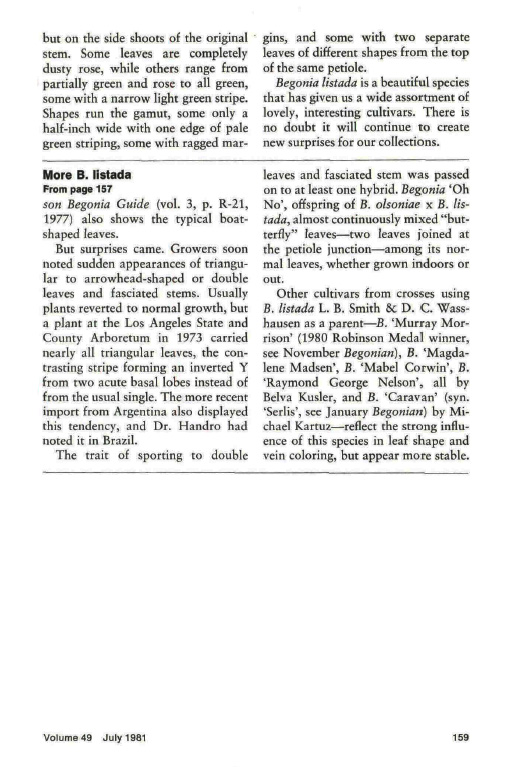La plante a été ajoutée en août 1961 au fond de semences de l’American Begonia Society, comme nouvelle espèce découverte au Brésil (Begonian 28: 162. août 1961 : « No.2-B. listada » – Nouvelle espèce du Brésil). Le nom était lié au collectionneur qui avait la plante en sa possession. A cette époque, la plante était totalement inconnue, même dans son Brésil natal où il n’existait que trois spécimens en culture. Le Dr Oswaldo Handro de l’Instituto de Botanica de Sao Paulo, au Brésil, a écrit à Sylvia Leatherman, directrice de la recherche sur l’ABS en 1955-60, qu’aucune description officielle n’avait été publiée.
En 1967, une lettre du Brésil au directeur de recherche de l’époque, Robert Shatzer, indiquait que la plante était une espèce rare qui poussait à Rio Grande do Suí.
Des années plus tard, en 1977, Tom Mentelos l’apporta à Thelma O’Reilly, non pas au Brésil, mais cette fois en provenance d’Argentine où elle avait été trouvée à l’intérieur des terres, à la frontière entre l’Argentine et le Paraguay. Pendant de nombreuses années, la plante a été étiquetée B. listada hort. L’abréviation « hort. » signifie horticulture, et signifie que c’est un nom horticole, pas un nom latin botanique officiel. Quand il a été déterminé qu’il s’agissait d’une espèce qui n’avait pas été décrite et n’avait donc aucun nom botanique officiel, T. O’Reilly de La Mesa, Californie a fourni au Smithsonian Institute un spécimen type.

Cette nouvelle espèce a été décrite et dénommée par Lyman Bradford Smith (1904-1997) et Dieter Carl Wasshausen (1938- ) dans The Begonian volume 48, page 155 à 159 en juillet 1981.
L’épithète spécifique listada vient de l’espagnol et signifie « rayée », une allusion au feuillage sombre à la nervure centrale bordée de vert plus vif.
L’espèce fait partie de la section Pritzelia.



Dans le même numéro, était publié un rappel de l’histoire de cette plante.



Plante à végétation buissonnante d’un développement moyen. Le port est érigé avec une tendance à devenir semi-retombante. Les feuilles allongées, en fer de lance sont recouvertes d’un fin duvet, ce qui lui donne une texture veloutée. La couleur des feuilles est vert foncé avec une raie centrale de long de la nervure principale blanche à vert clair. Les tiges et les pétioles sont vert-olive rougeâtre, recouverts de petits poils. Les fleurs blanches clairsemées apparaissent surtout en automne et en hiver, et sous une forte lumière, les bourgeons sont couverts de poils roses.
Occasionnellement, cette espèce va sporuler et produire des feuilles en forme de tête de flèche ou triangulaire, et même des fasciations sur une tige. Ce n’est pas une mutation stable, et la plante reviendra plus tard à la forme originale de la feuille. Ces anomalies ont été observées par le Dr. Handro dans la nature au Brésil, également. Cependant, une plante de l’Arboretum du Comté de Los Angeles conserve ces caractéristique de feuilles doubles, la bande claire formant un Y renversé sur le limbe.



B. listada, avec ses hybrides, est une espèce si caractéristique qu’elle a son propre groupe horticole : le feuillage distinctif, arbustif, bégonia de type listada.

B. listada a été utilisé pour créer de nombreux beaux hybrides. La texture de ses feuilles et leur motif de couleur semblent dominer. Dans une partie de sa longue descendance on trouve les Begonias ‘Caravan’ (désormais connu sous le nom B. ‘Serlis’), B. ‘Helen Michelson’, B. ‘Mabel Corwin’, B. ‘Magdalene Madsen’, B. ‘Murray Morrison’, B. ‘Oh No’, B.’Raymond George Nelson ; B. ‘Tuti Siregar’ (Hartutiningsih-M. Siregar – Bogor Botanical Gardens, Ouest Java, 2005)… sans oublier le difficile B. listada ‘Variegated’ sport aux feuilles zébrées de blanc-gris en travers des feuilles.

Растение было добавлено в августе 1961 года в семенной фонд Америанского Общества Бегоний как новый вид, открытый в Бразилии (Begonian 28: 162. август 1961 : « No.2-B. listada » – Новый вид из Бразилии). Название было дано коллекционером, который имел растение в коллекции. В эту эпоху растение было совершенно неизвестно, и даже в самой Бразии было только три экземпляра. Доктор Oswaldo Handro de Института Ботаники в Сан Поло в Бразилии написал директору исследований Sylvia Leatherman в 1955-60, что никаких официальных описаний не было опубликовано.
В 1967 году директор исследований Robert Shatzer получил письмо из Бразилии, в котором говорилось, что это растение является редким видом, которое растет в Rio Grande do Suí.
В 1977 Tom Mentelos привез растение для Thelma O’Reilly, в этот раз из Аргентины (на границе между Аргентиной и Парагваем).
В течении многих лет растение носило название B. listada hort. Сокращение holt. садовый, что означает, что это не официальное ботаническое название по латыни .
Когда растение было определено, речь шла о виде, который не был описан и не имел официального названия.
O’Reilly из La Mesa, Калифорня, доставил экземпляр в институт Smithsonian. Этот новый вид был описан учеными Lyman Bradford Smith (1904-1997) et Dieter Carl Wasshausen (1938- ) в издании The Begonian том 48, стр 155 – 159, июль 1981.
Эпитет listada взят из испанского языка и означает полосатый, так как лист растения темный с прожилками более яркого зеленого цвета.
В этом же номере опубликовано описание этого растения.
Растение кустарниковое средней высоты, Листья удлиненные, покрыты небольшими ворсинками, что придает им бархатистую структуру. Цвет листьев темно зеленый со светлыми прожилками светло зеленого цвета
Стебель и черенки красноватые, покрытые небольшими ворсинками. Цветки белые, цветут осенью и зимой при хорошем освещении. Почки покрыты ворсинками розоватого цвета.
Изредка этот вид размножается спорами и производит растение с листьями треугольной формы, Это не является окончательной формой мутации, так как через некоторое время растение приобретает первоначальный вид.
Эта аномалия была замечена доктором Handro в дикой природе в Бразилии. Однако, растения, которые находятся в Arboretum do Compté в Лос Анжелесе, имеют основые характеристики вида : двойные листья со светлой пололской в форме Y.
B. Listada со своими гибридами образует собственную группу : Бегония listada с отличительной листвой, кустарного типа.
B. Listada используется для получения новый красивый гибридов. Текстура ее листьев и цветовой рисунок являются доминирующими. Таким образом, в результате многолетнего скрещивания были получены такие растения как les Begonias ‘Caravan’ (сейчас известная под названием B. ‘Serlis’), B. ‘Helen Michelson’, B. ‘Mabel Corwin’, B. ‘Magdalene Madsen’, B. ‘Murray Morrison’, B. ‘Oh No’, B.’Raymond George Nelson’… а также B. listada ‘Variegated’ с листьями серо белого цвета между основной листвой.
Этот вид достаточно деликатный для разведения. Нуждается в теплом вдажном воздухе (18-20 градусов) весь год. Полив умеренный, лучше дождевой водой. Надо дать земле просохнуть между поливами.Хорошо реагирует на солнечный свет, но не любит прямых солнечных лучей, Яркие солнечные лучи замедляют рост растения, листья могут скручиваться и чернеть по бокам. Но при хорошем уходе, растение восстанавливается к осени, когда начинается вегетативный рост ( растение южного полушария с измененным сезонным режимом).
А теперь небольшой секрет, как узнать, что вы выращиваете действительно настоящую Begonia listada, а не ее гибрид. За океаном, это растение имеет еще название « Sun Tan Begonia » , так как оно темнеет на солнце, и на нем остаются следы от ожогов. Если вы положите монетку на лист и оставите лист на солнце, то через 15 или 30 минут, остальная часть листа потемнеет от солнца. Когда вы уберете монетку, на листе будет заметна светлая зона, которая находилась под монеткой.

C’est une espèce délicate en culture, à qui il faut apporter une atmosphère chaude (entre 18 et 20°C) toute l’année et une bonne humidité ambiante. Elle apprécie beaucoup de lumière mais sans soleil direct ainsi que des arrosages sans excès avec une eau non calcaire (eau de pluie). Le soleil direct estival ralentit ce bégonia et les feuilles peuvent s’enrouler ou brunir sur le bord. Avec un soin diligent, il se remettra à l’automne à la reprise de la végétation (et oui, c’est une espèce de l’hémisphère sud qui reste dessaisonnée). Il faut faire sécher le substrat entre deux arrosages.
Cette espèce est très facile à multiplier par bouture de tige feuillée ou même de feuille. Multipliée à partir d’une feuille, la bouture forme rapidement une plante compacte et touffue.
Enfin, une petite astuce, pour savoir si la plante que vous cultivez est réellement Begonia listada ou si c’est l’un de ses hybrides horticoles.
Souvenez-vous que cette espèce est connu, outre-Atlantique comme « Sun Tan Begonia » car, en effet, il bronze au soleil et on voit la trace du maillot. Si vous placez une pièce de monnaie sur une feuille et laissez la lumière du soleil tomber sur le reste de la feuille, après 15 ou 30 minutes, le reste de la feuille va s’assombrir du soleil. Lorsque vous retirez la pièce, une zone claire sera visible là où se trouvait la pièce.
Ce petit miracle aurait la réputation de ne pas fonctionner avec les cultivars.
The plant was added in August 1961 to the American Begonia Society seedbed, as a new species found in Brazil (Begonian 28: 162. August 1961: « No.2-B.listada » – New species from Brazil). The name was linked to the collector who had the plant in his possession. At that time, the plant was totally unknown, even in his native Brazil where there were only three specimens in culture. Dr. Oswaldo Handro of the Instituto de Botanica in Sao Paulo, Brazil, wrote to Sylvia Leatherman, director of ABS research in 1955-60, that no official description had been published.
In 1967, a letter from Brazil to the then research director, Robert Shatzer, indicated that the plant was a rare species that grew in Rio Grande do Suí.
Years later, in 1977, Tom Mentelos brought it to Thelma O’Reilly, not to Brazil, but this time from Argentina where she was found inland, on the border between Argentina and Paraguay. For many years, the plant has been labeled B. listada hort. The abbreviation « hort. » horticultural means, and means that it is a horticultural name, not an official Latin botanical name. When it was determined that this was a species that had not been described and therefore had no official botanical name, T. O’Reilly of La Mesa, California provided the Smithsonian Institute with a typical specimen .
This new species has been described and named by Lyman Bradford Smith (1904-1997) and Dieter Carl Wasshausen (1938-) in The Begonian volume 48, page 155-159 in July 1981. The specific epithet listada comes from Spanish and means « striped », an allusion to the dark foliage at the midrib edged with brighter green.
The species is part of the section Pritzelia.
In the same issue, was published a reminder of the history of this plant.
Plant with bushy vegetation of medium development. The habit is erected with a tendency to become semi-drooping. The elongated leaves, spearhead are covered with a fine down, which gives it a velvety texture. The color of the leaves is dark green with a central stripe along the white to light green main vein. The stems and petioles are reddish-olive green, covered with small hairs. The sparse white flowers appear mostly in autumn and winter, and under a strong light, the buds are covered with pink hairs.
Occasionally, this species will sporulate and produce leaves in the shape of an arrowhead or triangular, and even fasciations on a stem. It is not a stable mutation, and the plant will return to the original form of the leaf later. These abnormalities have been observed by Dr. Handro in the wild in Brazil, too. However, a plant in the Los Angeles County Arboretum retains these characteristics of double leaves, with the light band forming an inverted Y on the limb.
B. listada, with its hybrids, is a species so characteristic that it has its own horticultural group: distinctive foliage, shrub, begonia type listada.
B. listada has been used to create many beautiful hybrids. The texture of its leaves and their color pattern seem to dominate. In part of his long lineage are the Begonias ‘Caravan’ (now known as B. ‘Serlis’), B. ‘Helen Michelson’, B. ‘Mabel Corwin’, B. ‘Magdalene Madsen’, B. ‘Murray Morrison’, B. ‘Oh No’, B. ‘Raymond George Nelson’ … not to mention the difficult B. listada’ Variegated’ zebra leaf sport of white-gray across the leaves.
It is a delicate species in culture, to which it is necessary to bring a warm atmosphere (between 18 and 20 ° C) all the year and a good ambient humidity. She enjoys a lot of light but without direct sun as well as watering without excess with non-calcareous water (rainwater). The direct summer sun slows down this begonia and the leaves may curl or brown on the edge. With diligent care, he will recover in the fall when the vegetation returns (and yes, it is a species of the southern hemisphere that remains unseasoned). It is necessary to dry the substrate between two waterings.
This species is very easy to propagate by cutting leaf stems or even leaves. Multiplied from a leaf, the cutting quickly forms a compact and bushy plant.
Finally, a little tip, to know if the plant you grow is actually Begonia listada or if it is one of its horticultural hybrids.
Remember that this species is known across the Atlantic as « Sun Tan Begonia » because, indeed, it is bronze in the sun and we see the trace of the shirt. If you place a coin on a leaf and let the sunlight fall on the rest of the leaf, after 15 or 30 minutes, the rest of the leaf will darken from the sun. When you remove the room, a clear area will be visible where the coin was.
This little miracle would have the reputation of not working with cultivars.






















